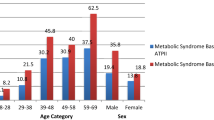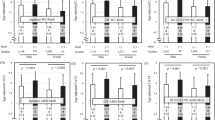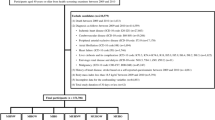Abstract
Abdominal obesity is a prerequisite for some definitions of metabolic syndrome (MetS). We investigated the impact of MetS defined by two different criteria, which either did or did not require abdominal obesity as a prerequisite, on cardiovascular disease (CVD) incidence in an urban Japanese cohort study. We studied 5,332 Japanese (aged 30–79 years, without CVD at baseline), who completed a baseline survey (September 1989 to March 1994) and were followed up through December 2005. MetS was defined by the NCEP-ATPIII (modified by Asian obesity criteria) and the Japanese criteria. After 61,846 person-years of follow-up, we documented 317 CVD incidences. The MetS frequencies of the Japanese and of the modified NCEP-ATPIII criteria were 17.7% and 25.1% for men and 5.0% and 14.3% for women, respectively. The multivariate hazard ratios (HRs; 95% confidence intervals [CI]) of CVD incidence for MetS by the modified NCEP-ATPIII criteria were 1.75 (1.27–2.41) in men and 1.90 (1.31–2.77) in women, and those for MetS by the Japanese criteria were 1.34 (0.96–1.87) in men and 2.20 (1.31–3.68) in women. The multivariate HRs of CVD incidence for MetS for the Japanese and for the modified NCEP-ATPIII criteria were 2.92 (1.54–5.55) and 1.94 (0.98–3.82) in men under 60 years old, respectively. The CVD incidence risks increased according to the number of MetS components. The risks were similar among participants with the same number of MetS components, regardless of abdominal obesity. In conclusion, the number of MetS components (modified NCEP-ATPIII criteria) may be more strongly associated with CVD incidence than the abdominal obesity essential criteria (the Japanese criteria) in a general urban Japanese population.
Similar content being viewed by others
Article PDF
References
Eckel RH, Grundy SM, Zimmet PZ : The metabolic syndrome. Lancet 2005; 365: 1415–1428.
Galassi A, Reynolds K, He J : Metabolic syndrome and risk of cardiovascular disease: a meta-analysis. Am J Med 2006; 119: 812–819.
Iso H, Sato S, Kitamura A, et al: Metabolic syndrome and the risk of ischemic heart disease and stroke among Japanese men and women. Stroke 2007; 38: 1744–1751.
Kadota A, Hozawa A, Okamura T, et al: Relationship between metabolic risk factor clustering and cardiovascular mortality stratified by high blood glucose and obesity: NIPPON DATA90, 1990 2000. Diabetes Care 2007; 30: 1533–1538.
Niwa Y, Ishikawa S, Gotoh T, Kayaba K, Nakamura Y, Kajii E : Metabolic syndrome mortality in a populationbased cohort study: Jichi Medical School (JMS) Cohort Study. J Epidemiol 2007; 17: 203–209.
Ninomiya T, Kubo M, Doi Y, et al: Impact of metabolic syndrome on the development of cardiovascular disease in a general Japanese population: the Hisayama study. Stroke 2007; 38: 2063–2069.
Takeuchi H, Saitoh S, Takagi S, et al: Metabolic syndrome and cardiac disease in Japanese men: applicability of the concept of metabolic syndrome defined by the National Cholesterol Education Program–Adult Treatment Panel III to Japanese men—the Tanno and Sobetsu Study. Hypertens Res 2005; 28: 203–208.
Hunt KJ, Resendez RG, Williams K, Haffner SM, Stern MP : National Cholesterol Education Program versus World Health Organization metabolic syndrome in relation to allcause and cardiovascular mortality in the San Antonio Heart Study. Circulation 2004; 110: 1251–1257.
Kahn R, Buse J, Ferrannini E, Stern M : The metabolic syndrome: time for a critical appraisal: joint statement from the American Diabetes Association and the European Association for the Study of Diabetes. Diabetes Care 2005; 28: 2289–2304.
Arenillas JF, Moro MA, Davalos A : The metabolic syndrome and stroke: potential treatment approaches. Stroke 2007; 38: 2196–2203.
Alberti KG, Zimmet P, Shaw J : Metabolic syndrome—a new world-wide definition. A Consensus Statement from the International Diabetes Federation. Diabet Med 2006; 23: 469–480.
Grundy SM, Cleeman JI, Daniels SR, et al: Diagnosis and management of the metabolic syndrome: an American Heart Association/National Heart, Lung, and Blood Institute Scientific Statement. Circulation 2005; 112: 2735–2752.
Tanaka H, Yokoyama T, Yoshiike N, Kokubo Y : Cerebrovascular disease, in Detels R, McEwen J, Beaglehole R, Tanaka H (eds): Oxford Textbook of Public Health: The Scope of Public Health. Oxford, Oxford University Press, 2002, pp 1193–1254.
Matsuzawa Y : Metabolic syndrome definition and diagnostic criteria in Japan. J Atheroscler Thromb 2005; 12: 301.
Definition and the diagnostic standard for metabolic syndrome—Committee to Evaluate Diagnostic Standards for Metabolic Syndrome. Nippon Naika Gakkai Zasshi 2005; 94: 794–809 ( in Japanese).
Kokubo Y, Inamoto N, Tomoike H, et al: Association of genetic polymorphisms of sodium-calcium exchanger 1 gene, NCX1, with hypertension in a Japanese general population. Hypertens Res 2004; 27: 697–702.
Kokubo Y, Tomoike H, Tanaka C, et al: Association of sixty-one non-synonymous polymorphisms in forty-one hypertension candidate genes with blood pressure variation and hypertension. Hypertens Res 2006; 29: 611–619.
Executive Summary of the Third Report of the National Cholesterol Education Program (NCEP) Expert Panel on Detection, Evaluation, and Treatment of High Blood Cholesterol in Adults (Adult Treatment Panel III). JAMA 2001; 285: 2486–2497.
James PT, Leach R, Kalamara E, Shayeghi M : The worldwide obesity epidemic. Obes Res 2001; 9 ( Suppl 4): 228S–233S.
New criteria for ‘obesity disease’ in Japan. Circ J 2002; 66: 987–992.
Walker AE, Robins M, Weinfeld FD : The National Survey of Stroke. Clinical findings. Stroke 1981; 12: I13–I44.
Tunstall-Pedoe H, Kuulasmaa K, Amouyel P, Arveiler D, Rajakangas AM, Pajak A : Myocardial infarction and coronary deaths in the World Health Organization MONICA Project. Registration procedures, event rates, and case-fatality rates in 38 populations from 21 countries in four continents. Circulation 1994; 90: 583–612.
Yudkin JS, Stehouwer CD, Emeis JJ, Coppack SW : C-reactive protein in healthy subjects: associations with obesity, insulin resistance, and endothelial dysfunction: a potential role for cytokines originating from adipose tissue? Arterioscler Thromb Vasc Biol 1999; 19: 972–978.
Meigs JB, O'Donnell C J, Tofler GH, et al: Hemostatic markers of endothelial dysfunction and risk of incident type 2 diabetes: the Framingham Offspring Study. Diabetes 2006; 55: 530–537.
Lteif AA, Han K, Mather KJ : Obesity, insulin resistance, and the metabolic syndrome: determinants of endothelial dysfunction in whites and blacks. Circulation 2005; 112: 32–38.
Ceriello A, Motz E : Is oxidative stress the pathogenic mechanism underlying insulin resistance, diabetes, and cardiovascular disease? The common soil hypothesis revisited. Arterioscler Thromb Vasc Biol 2004; 24: 816–823.
Despres JP, Lemieux I : Abdominal obesity and metabolic syndrome. Nature 2006; 444: 881–887.
Van Gaal LF, Mertens IL, De Block CE : Mechanisms linking obesity with cardiovascular disease. Nature 2006; 444: 875–880.
Balkau B, Deanfield JE, Despres JP, et al: International Day for the Evaluation of Abdominal Obesity (IDEA): a study of waist circumference, cardiovascular disease, and diabetes mellitus in 168,000 primary care patients in 63 countries. Circulation 2007; 116: 1942–1951.
Author information
Authors and Affiliations
Corresponding author
Rights and permissions
About this article
Cite this article
Kokubo, Y., Okamura, T., Yoshimasa, Y. et al. Impact of Metabolic Syndrome Components on the Incidence of Cardiovascular Disease in a General Urban Japanese Population: The Suita Study. Hypertens Res 31, 2027–2035 (2008). https://doi.org/10.1291/hypres.31.2027
Received:
Accepted:
Issue Date:
DOI: https://doi.org/10.1291/hypres.31.2027
Keywords
This article is cited by
-
Differences in the components of metabolic syndrome by age and sex: a cross-sectional and longitudinal analysis of a cohort of middle-aged and older Japanese adults
BMC Geriatrics (2023)
-
Metabolic syndrome is a risk factor for cancer mortality in the general Japanese population: the Jichi Medical School Cohort Study
Diabetology & Metabolic Syndrome (2019)
-
The Japanese Society of Hypertension Guidelines for the Management of Hypertension (JSH 2019)
Hypertension Research (2019)
-
Chapter 1. Epidemiology of hypertension
Hypertension Research (2014)
-
Abnormality of risk factors for atherosclerotic disease among young Japanese aged 19–39 years old: an evaluation of health checkup data
Environmental Health and Preventive Medicine (2013)



